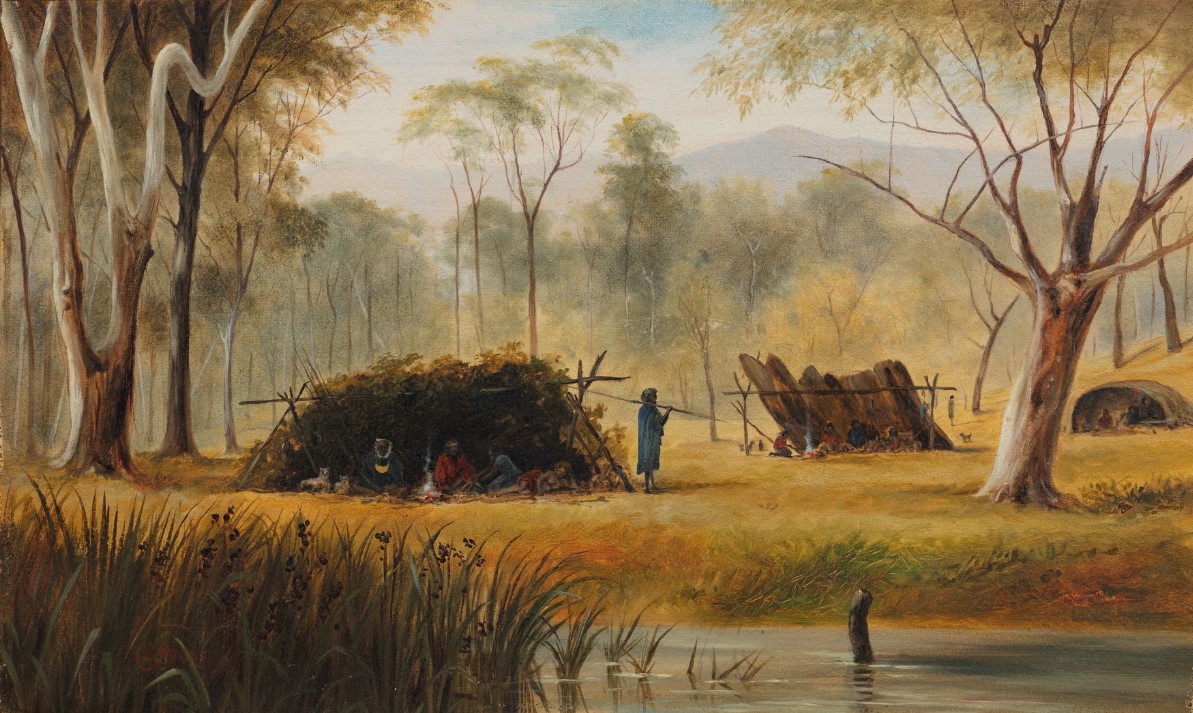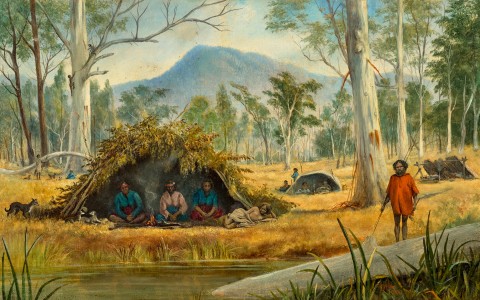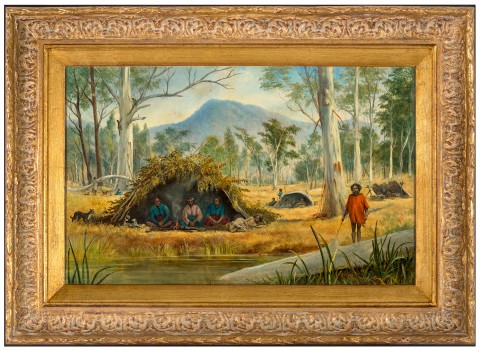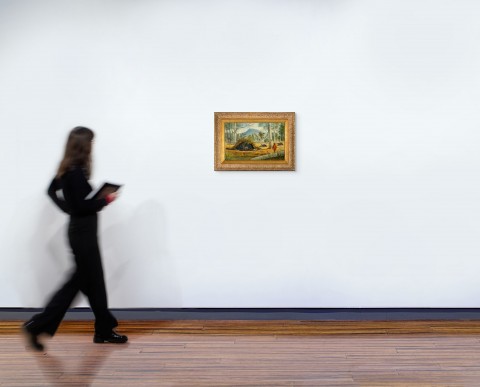[ABORIGINAL CAMP, VICTORIA], 1884
EDWARD ROPER
oil on canvas
32 x 50.5 cm
signed and dated lower right: E Roper / 1884
Private collection, Queensland
Bonhams, Sydney, 23 August 2022, lot 51 (as ‘Aboriginal Camp’)
Private collection, Sydney
possibly: Colonial fine art exhibition: catalogue of Australian & New Zealand, Canadian & American oil paintings, and watercolour drawings under the patronage of Sir Saul Samuel K.C.M.G., Burlington Gallery, London, 1886, cat. 10 (as '“Their only Home”, a Black’s Mia–mia, Victoria’)
Aboriginal encampment by a river in the collection of the Art Gallery of Ballarat, Victoria, probably exhibited: Exhibition of Pictures of our Colonies, The Great Assembly Hall, London, 1893, cat. 122 as Native Mia-Mias, on the Avoca, 1856
Roper.jpg

‘…Having resided for many years in various parts of the British Colonies, [Mr Roper] made the different features of those countries the subjects of his brush and pencil, depicting the scenery and animal life which surrounded him, showing the mode of life pursued by the Colonists and the Natives, also introducing various sporting and hunting scenes’.1
In 1870 the painter, illustrator, engraver and lithographer, writer, photographer and prolific traveller Edward Roper presented to the Deptford Emigration Society, stating ‘To my mind Australia is the most wonderful country that ever was and I believe ever can be again: the way it has progressed during the last fifteen years is something tremendous’.2 English-born Roper had first visited Australia in the 1850s, spending the years 1852–56 on the Victorian goldfields. Although then only in his early twenties, he was already well-travelled, having sailed as a midshipman to the West Indies prior to emigrating with his family to Canada when a teenager: by 1870, Roper said, ‘I have crossed the Atlantic to America and back some ten times, four times in emigrant ships.’3
Roper returned to Australia in 1870, travelling from England to Canada, via train across the United States, then sailing to Hawai’i, New Zealand and New South Wales. In 1871 he established a Melbourne branch of the Graphotype Engraving Company, a form of reproductive printmaking, which he ran until 1873.4 By this time Roper was an experienced illustrator, producing sketches and watercolours, although he is not known to have exhibited his art while in Australia. He took up oil painting following his return to England where he spent his later years, while travelling frequently to Canada. Family records suggest that he undertook study in Paris; certainly his subsequent painting, drawing upon earlier sketches, was prolific, often repeating his topics. During the 1880s and 1890s, he exhibited extensively in group and solo exhibitions in London, with subjects ranging from Canadian snowscapes to Māori kiwi hunting, goldrush scenes to felling giant eucalypts to, as here, forms of Indigenous architecture. In addition, Roper wrote and spoke widely about his extensive travels and experiences, particularly in North America.
Painted in 1884, this scene of Indigenous habitation among towering gums might be the work titled “Their only home”, a Black’s mia-mia, Victoria, which was exhibited in 1886.5 Roper is known to have visited the Wimmera and Grampian regions of western Victoria in 1870–71, which might be depicted here; photographs he took of his party are held in the State Library of New South Wales. This oil painting, and a closely related watercolour in the Ballarat Art Gallery, were probably also the result of photography: the three styles of built structures seen here are highly unlikely to have been used simultaneously but are amalgamated to convey ethnographic information and colonial spectacle, rather than regional accuracy. Photographs of Aboriginal families similarly posed were common and may have been taken by Roper himself or produced commercially. Roper was awarded a gold medal for paintings displayed at the 1905 Colonial and Indian Exhibition in London’s Crystal Palace, the year before that edifice burnt down, and four years before his own death.6
1. Exhibition advertisement, Egyptian Hall, London, 1890s, illustrated at https://samizdatpress.typepad.com/issue_three2_fall_2010/edward-roper-by...
2. Edward Roper, What Emigration really is: By a Resident in Canada and Australia with Illustrations by the Author, paper for the Deptford Emigration Society, London 1870
3. ibid.
4. ‘Graphotype’, The Argus 9 Oct. 1872 , p. 1
5. A painting of this title was also exhibited in London in 1873 (see Exhibition History above).
6. Extensive research on Roper’s life and Canadian art has been undertaken by Jim Burant, Hamilton Arts & Letters, Fall 2010 and following, https://samizdatpress.typepad.com/issue_three2_fall_2010/edward-roper-by...
ALISA BUNBURY


